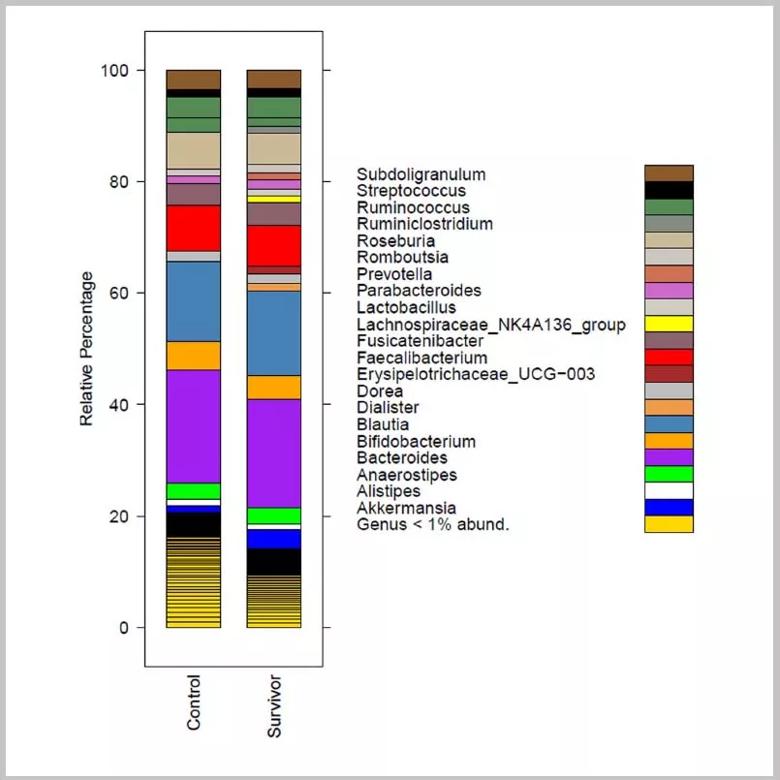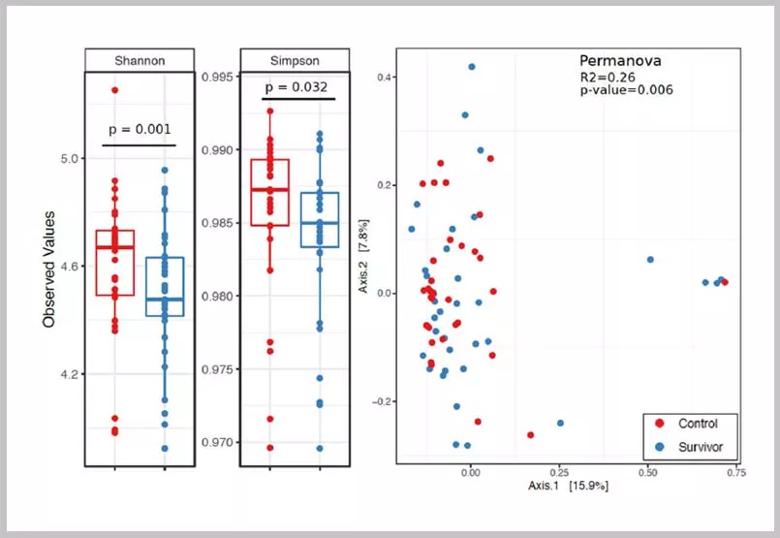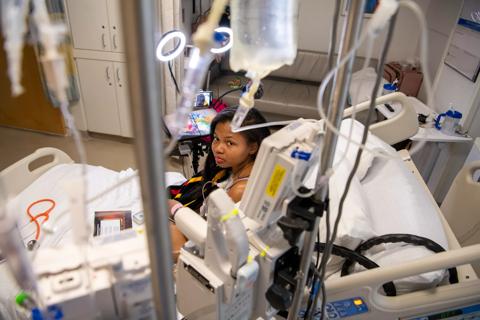Study shows long-term survivors of childhood cancer have decreased gut bacterial microbiome diversity

Advertisement
Cleveland Clinic is a non-profit academic medical center. Advertising on our site helps support our mission. We do not endorse non-Cleveland Clinic products or services. Policy
Improvements in treatment for childhood cancer patients have led to more than 80% of patients becoming long-term survivors in the United States. However, among long-term survivors, the rates of chronic severe health conditions remain greatly elevated compared to those of the general population.
Metabolic syndrome and obesity occur commonly in long-term survivors and exacerbate other chronic health conditions.1 Chronic inflammation has several mechanistic links to obesity and metabolic syndrome,2 and long-term survivors of pediatric malignancies show evidence of chronic inflammation.3 How chronic inflammation is mechanistically related to long-term side effects in survivors is still poorly understood.
Active treatment for cancer patients clearly alters the intestinal microbiome;4 however, it is less clear if these changes persist many years after treatment. Antibiotic use in infancy is associated with an increased risk of obesity in later years5, and changes in the microbiome have been associated with several components of metabolic syndrome in the general population.6,7 These findings have led some to propose that cancer treatment may lead to microbiome reconstitution with pro-inflammatory organisms that increase the risk for metabolic syndrome.8
We hypothesized that long-term survivors of pediatric cancer and blood and marrow transplantation would have reduced bacterial microbiome diversity compared to controls, and these findings would be associated with components of metabolic syndrome and chronic inflammation.
Advertisement
To test this hypothesis, and with the potential to generate new hypotheses, we performed a single-center, cross-sectional exploratory study examining the microbiome, clinical factors, and multiple biomarkers of insulin resistance, adiposity, and inflammation between 35 long-term survivors and 32 age, sex, and race matched controls. All subjects were ages 10 to 40 years, and survivors were at least five years from the time of diagnosis therapy completion.
Groups demonstrated similar diet types and quality, birth via caesarian section or vaginally, having been breastfed as an infant, and body mass index. The survivor cohort also underwent chart review to determine cancer type and treatment history, clinical laboratory analysis, and additional survey questions.
After collecting fecal specimens and performing 16S sequencing, in aggregate, survivors and controls had differently abundant bacterial phyla (Figure 1). In order to determine if within-sample diversity (α-diversity) of each group differed, we calculated the Shannon and Simpson diversity indices (which takes into account both evenness and richness of communities) of the samples from survivors and controls. Evaluation of the bacterial microbiome demonstrated reduced alpha diversity (P < 0.05) utilizing both Shannon and Simpson indices (Figure 2a). Bray-Curtis dissimilarity index was used to determine differences in bacterial taxonomic composition between the case and control groups (β-diversity). β-diversity comparisons (between specimens from both groups showed modest differential clustering (R2=0.26, P = 0.006) (Figure 2b).
Advertisement

Figure 1. Genus-level abundance in controls and survivors.
Reprinted with permission from Taylor & Francis Ltd. Originally appeared in the following: Rotz SJ, Sangwan N, Nagy M, Tzeng A, Jia M, Moncaliano M, Majhail NS, Eng C. Fecal microbiota of adolescent and young adult cancer survivors and metabolic syndrome: an exploratory study. Pediatr Hematol Oncol. 2022 Mar 10:1-15. doi: 10.1080/08880018.2022.2049937. Epub ahead of print. PMID: 35271405.

Figure 2. α- and β-diversity of bacterial communities in survivors and controls. (a) α-diversity based
on Shannon and Simpson index (b) β-diversity displayed as principal coordinate analysis based on
Bray–Curtis dissimilarity index.
Reprinted with permission from Taylor & Francis Ltd. Originally appeared in the following: Rotz SJ, Sangwan N, Nagy M, Tzeng A, Jia M, Moncaliano M, Majhail NS, Eng C. Fecal microbiota of adolescent and young adult cancer survivors and metabolic syndrome: an exploratory study. Pediatr Hematol Oncol. 2022 Mar 10:1-15. doi: 10.1080/08880018.2022.2049937. Epub ahead of print. PMID: 35271405.
We also examined the role of radiation therapy on the microbiome in the survivor cohort. Survivors who had radiation exposure to the abdomen or pelvis or central nervous system were compared to those survivors who did not receive radiation to these locations. For those who received radiation, α-diversity, as measured by Shannon and Simpson indices, was reduced compared to those that did not (P < 0.05 for both locations and indices).
Advertisement
Although, no specific component of metabolic syndrome or cytokine was associated with measures of alpha diversity, survivors with low adiponectin-lectin ratio, elevated body mass index, and elevated C-Reactive protein had differently abundant taxa compared to those with normal measures.
Overall, this study demonstrates that long-term survivors of childhood cancer have decreased gut bacterial microbiome diversity and differently abundant bacterial taxa, even years after the completion of therapy. Additionally, radiation may be particularly important in microbial diversity among this cohort.
In future experiments, we aim to further categorize the metabolome in a similar cohort of patients to better understand if the difference found on 16S sequencing results in alterations of metabolic products in the bloodstream. We also aim to explore potential relationships with the fungal microbiome and gain a better understanding of mechanisms via gnotobiotic mouse experiments. Further, in order to detect associations with clinically relevant late effects, we aim to perform a larger multicenter study using older subjects with a greater prevalence of comorbidities.
About the author: Dr. Rotz is Assistant Professor of Pediatrics, Cleveland Clinic Lerner College of Medicine at Case Western Reserve University.
References
1. de Haas EC, Oosting SF, Lefrandt JD, Wolffenbuttel BH, Sleijfer DT, Gietema JA. The metabolic syndrome in cancer survivors. Lancet Oncol. Feb 2010;11(2):193-203. doi:10.1016/S1470-2045(09)70287-6
Advertisement
2. Monteiro R, Azevedo I. Chronic inflammation in obesity and the metabolic syndrome. Mediators Inflamm. 2010;2010doi:10.1155/2010/289645
3. Ariffin H, Azanan MS, Abd Ghafar SS, et al. Young adult survivors of childhood acute lymphoblastic leukemia show evidence of chronic inflammation and cellular aging. Cancer. Nov 1 2017;123(21):4207-4214. doi:10.1002/cncr.30857
4. Rotz SJ, Dandoy CE. The microbiome in pediatric oncology. Cancer. Jun 13 2020;doi:10.1002/cncr.33030
5. Saari A, Virta LJ, Sankilampi U, Dunkel L, Saxen H. Antibiotic exposure in infancy and risk of being overweight in the first 24 months of life. Pediatrics. Apr 2015;135(4):617-26. doi:10.1542/peds.2014-3407
6. Org E, Blum Y, Kasela S, et al. Relationships between gut microbiota, plasma metabolites, and metabolic syndrome traits in the METSIM cohort. Genome Biol. Apr 13 2017;18(1):70. doi:10.1186/s13059-017-1194-2
7. Turnbaugh PJ, Hamady M, Yatsunenko T, et al. A core gut microbiome in obese and lean twins. Nature. Jan 22 2009;457(7228):480-4. doi:10.1038/nature07540
8. Rosen GP, Nguyen HT, Shaibi GQ. Metabolic syndrome in pediatric cancer survivors: a mechanistic review. Pediatr Blood Cancer. Dec 2013;60(12):1922-8. doi:10.1002/pbc.24703
Advertisement

Pediatric specialists unpack new evidence, considerations for care and what’s ahead

Leaders of the Pediatric Cancer Committee discuss new accreditation

The latest evidence to support ‘practice-changing’ protocol—and a note of caution

Largest study of its kind identifies three treatment exposures that contribute to risk

AHA recommendations for pretransplant evaluation, peritransplant and long-term management

Data from combined prospective and retrospective cohorts support the drug’s safety and efficacy for CLVM

Efficacy, safety and tolerability data shared at hematology meeting

New guidelines expand on psychosocial, sexual health, cognitive and other issues